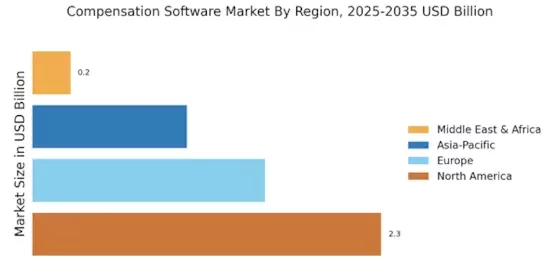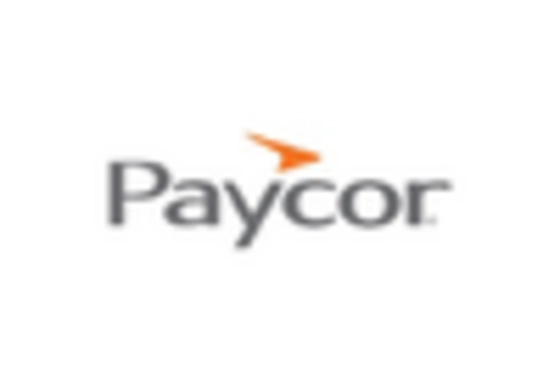The Compensation Software Market is currently characterized by a dynamic competitive landscape, driven by the increasing demand for efficient payroll management, compliance with regulatory requirements, and the integration of advanced technologies. Major players such as Workday (US), SAP (DE), and Oracle (US) are strategically positioned to leverage their technological capabilities and extensive customer bases. Workday (US) focuses on continuous innovation in its cloud-based solutions, enhancing user experience and operational efficiency. SAP (DE) emphasizes its comprehensive suite of enterprise resource planning (ERP) solutions, integrating compensation management with broader business processes. Oracle (US) is known for its robust analytics capabilities, which allow organizations to make data-driven compensation decisions. Collectively, these strategies contribute to a competitive environment that prioritizes technological advancement and customer-centric solutions.
In terms of business tactics, companies are increasingly localizing their offerings to cater to diverse regulatory environments and cultural nuances across regions. This localization, coupled with supply chain optimization, is essential for maintaining competitiveness in a moderately fragmented market. The collective influence of key players shapes the market structure, as they engage in strategic partnerships and collaborations to enhance their service offerings and expand their market reach.
In August 2025, Workday (US) announced a partnership with a leading AI firm to integrate machine learning capabilities into its compensation software. This strategic move is expected to enhance predictive analytics, allowing organizations to forecast compensation trends more accurately and make informed decisions. The integration of AI not only positions Workday (US) as a leader in innovation but also reflects the growing importance of data-driven insights in compensation management.
In September 2025, SAP (DE) launched a new feature within its SuccessFactors platform aimed at automating compensation planning processes. This initiative is significant as it streamlines workflows and reduces administrative burdens for HR departments, thereby enhancing overall efficiency. By automating these processes, SAP (DE) reinforces its commitment to providing comprehensive solutions that address the evolving needs of organizations in managing compensation.
In October 2025, Oracle (US) unveiled an upgraded version of its HCM Cloud, which includes enhanced compensation analytics tools. This upgrade is crucial as it allows organizations to analyze compensation data in real-time, facilitating more agile decision-making. Oracle's focus on real-time analytics underscores the trend towards immediate access to data, which is becoming increasingly vital in the fast-paced business environment.
As of October 2025, the Compensation Software Market is witnessing trends such as digitalization, sustainability, and the integration of artificial intelligence. Strategic alliances among key players are shaping the competitive landscape, fostering innovation and enhancing service delivery. Looking ahead, competitive differentiation is likely to evolve from traditional price-based competition to a focus on technological innovation, reliability in supply chains, and the ability to provide tailored solutions that meet the specific needs of diverse organizations.


















Leave a Comment